India's Toxic Taps: A Deep Dive into the Groundwater Crisis of Arsenic, Fluoride, and Nitrates
The latest reports from the Central Ground Water Board paint a grim picture: millions of Indians are drinking a silent poison.

Written by Lavanya, Intern, Allegedly The News
New Delhi, India, August 13, 2025
The statistics are staggering. The Central Ground Water Board's (CGWB) latest Annual Groundwater Quality Report 2024, released in December 2024, reveals a silent national health emergency. Out of over 15,000 groundwater samples analyzed across the country, a significant number were found to be contaminated with toxins far exceeding permissible limits. While 19.8% of the samples showed the presence of nitrates beyond the safety threshold, 9.04% were contaminated with fluoride, and 3.1% with arsenic. This isn't just a data point; it's a slow-motion catastrophe impacting the health and livelihoods of millions, primarily in rural India, where groundwater is the only source of drinking water.
The Silent Killers: How These Contaminants Poison a Nation
For most of India, the threat isn't visible. The water may look clear and taste normal, but it holds a toxic cocktail of contaminants that, over time, wreak havoc on the human body.
Arsenic: The Carcinogenic Threat from the Earth
Arsenic is a naturally occurring metalloid found in the Earth’s crust. In regions with specific geological formations, it leaches from rocks and sediments into groundwater. The Gangetic plains, a lifeline for millions, are also a major hotspot for arsenic contamination. The latest data reveal that parts of Bihar, Uttar Pradesh, West Bengal, Assam, and Punjab are most severely affected, with thousands of villages having groundwater with arsenic concentrations far above the WHO-prescribed limit of 10 ppb (parts per billion).
The health impacts are chronic and severe, a condition known as arsenicosis. Initial symptoms are often subtle: skin lesions, hyperpigmentation, and hardened patches on the palms and soles (hyperkeratosis). These are often mistaken for common skin diseases. However, prolonged exposure can lead to a host of debilitating and often fatal diseases, including skin, bladder, and lung cancers, as well as cardiovascular disorders, diabetes, and neurological damage. The economic burden on affected families is immense, with a significant loss of productivity and high healthcare costs. In a preliminary survey, over 10,000 patients were registered with various arsenic-related signs and symptoms in affected states.
Fluoride: Crippling Bones and Staining Smiles
Similar to arsenic, high levels of fluoride in groundwater are largely geogenic, originating from fluoride-rich rocks and soils. Fluoride is essential for healthy teeth and bones in small quantities, but in excess, it is a poison. Over 36% of India's districts, or 263 out of 722, now have groundwater with fluoride concentrations exceeding the permissible limit of 1.5 mg/L.
The most visible sign of contamination is dental fluorosis, an irreversible mottling and staining of tooth enamel that is particularly prevalent among children. Far more debilitating is skeletal fluorosis, a painful condition that causes stiffness and pain in joints, calcification of ligaments, and, in advanced stages, crippling deformities of the spine and limbs. This renders affected individuals physically incapacitated, leading to a loss of livelihood and a cycle of poverty. States with a high prevalence of fluorosis include Rajasthan, Telangana, Andhra Pradesh, Gujarat, Haryana, and Punjab. For instance, a recent report in The Hindu noted that in Telangana alone, 28 out of 33 districts have a higher concentration of fluoride in their groundwater. In some tribal villages of Rajasthan, fluoride levels are so high that more than 75% of children suffer from dental fluorosis and over 17% from skeletal fluorosis.
Nitrates: The Invisible Threat from the Farm
Nitrate contamination is primarily a man-made crisis. It stems from the indiscriminate use of nitrogenous fertilizers in agriculture, untreated sewage, and industrial effluents that seep into the ground. While less immediately toxic to adults, nitrates pose a severe risk to infants, causing methemoglobinemia, or "blue baby syndrome." This life-threatening condition occurs when nitrates interfere with the blood's ability to carry oxygen, causing a bluish discoloration of the skin and potentially leading to death if not treated promptly.
The CGWB's latest report found that over 440 districts in India have high nitrate levels, with hotspots identified in states like Rajasthan, Karnataka, and Tamil Nadu. The problem is directly linked to the widespread, and often subsidized, use of urea and other chemical fertilizers, a legacy of the Green Revolution. This excessive application has led to a significant nutrient imbalance in the soil, causing nitrates to leach into the groundwater.
The Anatomy of a Crisis: Weak Enforcement and Unsustainable Practices
The groundwater crisis is not just a problem of geology or agriculture; it is a profound failure of governance and a consequence of unsustainable development.
Fragmented Governance and Regulatory Gaps
Water management in India is a fragmented mess. Different government bodies, the Central Ground Water Board, the Central Pollution Control Board (CPCB), and various state-level agencies often operate independently, with little to no coordination. The absence of a robust, pan-India legal framework for groundwater regulation means that borewell drilling and water extraction are largely unregulated. This has created a "free-for-all" scenario where aquifers are relentlessly exploited, leading to falling water tables and an increased concentration of contaminants in the remaining water. A 2024 parliamentary question highlighted that while the Jal Jeevan Mission (JJM) prioritizes quality-affected habitations, the implementation is often slow, and the sheer scale of the problem outpaces the pace of corrective action.

The Industrial and Agricultural Connection
Beyond farming, industrial negligence is a major contributor to the crisis. Many industries, particularly those involved in textile, tannery, and chemical manufacturing, discharge untreated effluents into water bodies or directly onto the ground. These effluents contain heavy metals and other chemicals that eventually find their way into groundwater. The weak enforcement of environmental laws and a lack of political will to crack down on powerful industrial lobbies allow this pollution to continue unabated.
Unsustainable farming practices are perhaps the single largest human factor. The heavy subsidization of chemical fertilizers, especially urea, has created a skewed NPK (Nitrogen, Phosphorus, Potassium) ratio in the soil. Farmers are incentivized to overuse nitrogen-based fertilizers, leading to substantial nitrate runoff. This vicious cycle not only degrades soil health but also pollutes the very water that is used to grow crops.
Climate Stress: The Multiplier Effect
Climate change is not a separate issue but a compounding factor that intensifies all existing water problems.
- Erratic Rainfall and Drought: More frequent and severe droughts, driven by climate change, lead to a drastic reduction in groundwater recharge. As water tables drop, the concentration of existing contaminants like arsenic and fluoride increases, making the remaining water even more toxic.
- Intense Flooding: Conversely, extreme rainfall events and floods can overwhelm sanitation systems and flush surface pollutants—from agricultural fields, industrial sites, and urban areas—directly into shallow aquifers, contaminating them.
- Sea-Level Rise: In coastal areas, rising sea levels are causing saltwater intrusion into freshwater aquifers. This not only makes the water unusable but can also mobilize geogenic contaminants, such as arsenic, from the soil into the groundwater.
A Roadmap for Clean Water Access: Technology, Policy, and Community
Addressing this crisis requires a comprehensive and multi-pronged strategy that combines technological innovation with fundamental policy and behavioral changes.
Low-Cost and Scalable Technologies
For a country as vast and diverse as India, the solution cannot be a one-size-fits-all approach. Low-cost, decentralized, and scalable technologies are crucial for providing safe water to rural populations.
- Arsenic Mitigation: Technologies like sorptive filtration using iron-coated sand filters or the simple "bucket treatment unit" that uses alum and iron salts to coagulate and remove arsenic are effective at the household level. For a community-wide solution, setting up community water purification plants (CWPPs) with reverse osmosis (RO) or oxidation-filtration technology is a viable option.
- Fluoride Removal: The Nalgonda technique, which uses alum and lime to precipitate fluoride, has been successfully implemented in various regions. Other effective methods include activated alumina and bone charcoal adsorption, which can be deployed in community-level filters.
- Nitrate and Multiple Contaminant Removal: While RO is highly effective against nitrates, it is expensive and generates a lot of wastewater. For community-level intervention, ion exchange is a promising technology. The government, under the Jal Jeevan Mission, is providing financial assistance for installing community water purification plants in quality-affected habitations.
Stricter Governance and Enforcement
The need for a unified, national water policy that integrates both surface and groundwater management is paramount. This policy must be backed by a strong, well-funded enforcement body with the authority to regulate borewell drilling, penalize industrial polluters, and monitor water quality in real time. The focus must shift from simply providing water to ensuring the water is safe.
Sustainable Agricultural Practices
Farmers must be incentivized to adopt sustainable practices. This includes promoting micro-irrigation techniques like drip and sprinkler systems to reduce groundwater extraction, and encouraging the use of organic fertilizers and bio-pesticides to minimize chemical runoff.

The Road Ahead: A Call to Action
The evidence is clear, and the data is alarming. The ongoing groundwater contamination crisis is not an abstract environmental problem; it is a health and human rights issue that is poisoning a generation. While technology offers a lifeline, the real solution lies in fundamental, systemic change. It requires a transformation in how we govern our natural resources, how we practice agriculture, and how we, as a society, value clean water. The time for action is now, before the silent killers lurking beneath the surface claim more lives and irrevocably damage the nation's future. We must move from awareness to action, from data to dialogue, and from policy to performance. The future of India's water, and the health of its people, depends on it.
What do you think?
The crisis of contaminated groundwater is a complex challenge with no easy answers. It forces us to ask some fundamental questions about our priorities and our future. How can India's vast and fragmented water governance be reformed to create a coherent, effective national strategy for groundwater management and quality control?
Sources
- Central Ground Water Board (CGWB) Annual Groundwater Quality Report 2024.
- The Hindu and other news outlets on specific state-level contamination reports.
- Parliament of India, Ministry of Jal Shakti reports and Q&A sessions.
- Scientific studies and research papers on arsenicosis and fluorosis.
- Wikipedia, Alarmy, Getty Images, Frontiers.




